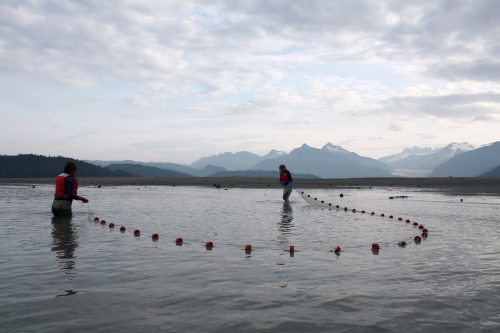Bagging barnacles, exploring a changing ecosystem
August 21, 2019
Tom Moran
907-474-5581

It’s a brilliant July Fourth morning outside of Juneau, and I’m bagging barnacles.
Armed with a paint scraper, tongs and a foam board to kneel on, I meticulously remove every bit of biomass from inside a ¼-by-¼-meter square of PVC pipe dropped onto a rocky section of beach near the mouth of Cowee Creek. I yank Fucus seaweed by the handful, massage blue mussels out by the roots and scrape off the barnacles, which I discover have innards like egg yolks. Everything goes into Ziploc bags, 10 in all. As I work my way down toward sand and bedrock, a seemingly endless supply of tiny snails materializes within the squares, one by one.
“I can’t believe how many snails there are here,” I comment.
“Yeah,” laughs Sydney King, a UAF College of Fisheries and Ocean Sciences technician who is scribbling down notes while examining a PVC square of her own. “Well, I have to count them.”
King and I are spending Independence Day hunkered on this remote stretch of shoreline as part of a much larger mission: to contribute to a running record of physical, biological and chemical conditions in the coastal Gulf of Alaska and the watersheds that feed it. It’s part of Fire and Ice, a five-year project by the Alaska National Science Foundation Established Program to Stimulate Competitive Research. The project is studying how climate change could impact marine life along the coastline.

“The goal of the Coastal Margins part of the Fire and Ice project is to understand how changes in freshwater are affecting downstream ecosystems,” explained Anne Beaudreau, an associate professor of fisheries at CFOS and co-lead of the coastal portion of Fire and Ice, during an interview outside her Juneau office. “We’re studying areas that are undergoing rapid change — there are changes in precipitation, glaciers are melting — and all that freshwater is moving downstream into the marine environment and affecting habitats and species there.”
The site at which we’re working, Cowee Creek, is one of 10 watersheds that are being sampled at monthly intervals, five of them along the Juneau road system and the other five in Kachemak Bay. Each watershed has a different level of glacial cover, from 63 percent on the Mendenhall River down to zero percent at a pair of other sites.
Part of the idea behind the project is to substitute space for time: to see how conditions vary based on levels of glaciation and to extrapolate those changes into a world with less glacial cover. “We expect that in the future, the areas that are currently covered by ice are going to start to look more and more like rain-fed systems,” Beaudreau said. “And so we hope that studying how the biology is changing across the gradient will give us a bit of a window into the future.”
The bags of snails and barnacles are bound for a freezer at the CFOS Lena Point facility and will ultimately head to a laboratory for analysis. King’s only products are data: She’s examining small plots of the intertidal zone and recording the surface composition and amounts of sea life. Meanwhile, a quarter-mile away, Beaudreau takes notes from a skiff as students and other volunteers haul a seine along a lonely stretch of beach. They lug the net on shore and examine the wriggling contents, which include a soggy mess of seaweed, the occasional starry flounder or salmon, and piles and piles of staghorn sculpin. Each fish is measured, logged and released back into the ocean. They’ve been at this for five days and five different sites, and will do it again in a month, and again a month after that, and each summer month for the next five years.
The ecological research is generating only a fraction of the data being gathered. Oceanic sensors, ocean drifters, plankton tows and remote sensing add to the team’s knowledge of local conditions over time. In addition to the nearshore work, “stream teams” in both Juneau and Kachemak Bay are studying water characteristics in the streams that feed the estuaries and working to link their findings to data from the coastline. Laboratory experiments and modeling will help scale up the local measurements to a broader region. In an upcoming phase of the ambitious project, the team will also interview resource users to understand how local knowledge and stewardship can help coastal communities adapt to environmental change.

In addition to the Coastal Margins research, another team of researchers in the $20 million Fire and Ice project is examining climate-induced changes to fire regimes in the boreal forest.
The project also incorporates educational research and a variety of outreach efforts across the state. It is funded by the National Science Foundation and the state of Alaska. For more information, visit www.alaska.edu/epscor.
Tom Moran is the communications manager for Alaska NSF EPSCoR.


